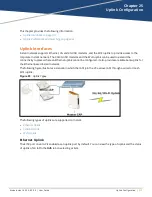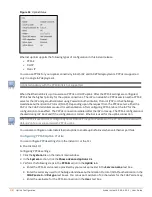
Using Central, individual users can manage their own wireless network. This user interface is accessible through
a standard web browser and can be launched using various browsers. Aruba Central uses a secure HTTPs
connection and provides a strong mutual authentication mechanism using certificates for all communication
with IAPs. These certificates ensure the highest level of protection.
Provisioning an IAP using Central
After you subscribe and register an IAP, log in to the Central dashboard to manage your IAP using the following
URL:
http://www.arubanetworks.com/iap-motd
The Central UI is categorized into the following sections:
1. Monitoring
2. Configuration
3. Reporting
4. Maintenance
These sections are layered under groups. The configuration details of the IAPs are defined at a group level. Any
IAP joining a group inherits the configuration defined for the group. After you create a group, navigate to the
Wireless Configuration section and create a new SSID. Aruba Central supports zero-touch provisioning, which
allows the network administrators to configure the IAPs even before the hardware arrives.
After you turn on the IAP and connect to the uplink port, the IAP is displayed under the default group in the
Aruba Central UI. You can choose to move the IAP to a different group that you created. The configuration
defined in this group is automatically applied to the IAP.
Maintaining the Subscription List
Aruba Central maintains a subscription list for the IAPs. If an IAP is not included in this list, Central identifies it
as an unauthorized IAP and prevents it from joining the network. The service providers use Aruba Central to
track the subscription of each IAP based on its serial number and MAC address.
The following types of subscription status are listed for the IAPs:
l
Active—Central allows the IAP to join the network.
l
Expired—Central denies the IAP from joining the network.
If the status of a master IAP changes from active to expired, the VC is set to factory defaults and it
reboots.
If the status of a slave IAP changes from active to expired, the VC sets the slave IAP to factory
defaults and reboots the IAP.
l
Unknown—Central does not allow the IAP to join the network. However, it gives an option to retry the
connection.
The list maintained by Aruba Central is different from the list maintained by the end users. Therefore, Central
can prevent an IAP from joining the network when the subscription expires, even if the IAP is present in the
subscription list maintained by the end user.
The subscription list is dynamic and gets updated each time an IAP is included in Central.
Aruba Instant 6.5.0.0-4.3.0.0 | User Guide
IAP Management and Monitoring |
315






























